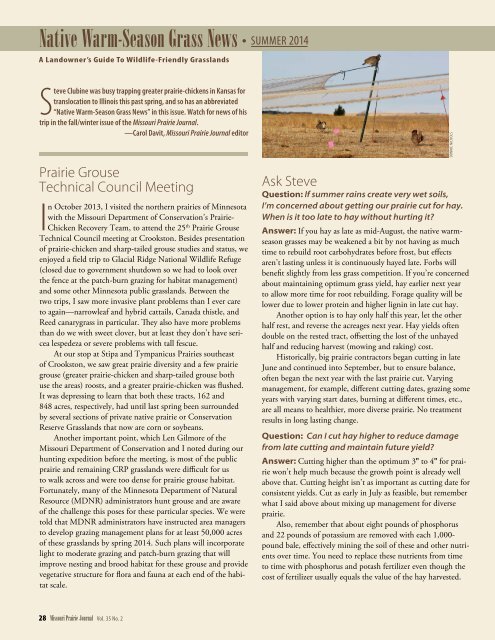yBg7W
yBg7W
yBg7W
Create successful ePaper yourself
Turn your PDF publications into a flip-book with our unique Google optimized e-Paper software.
Native Warm-Season Grass News • Summer 2014A Landowner’s Guide To Wildlife-Friendly GrasslandsSteve Clubine was busy trapping greater prairie-chickens in Kansas fortranslocation to Illinois this past spring, and so has an abbreviated“Native Warm-Season Grass News” in this issue. Watch for news of histrip in the fall/winter issue of the Missouri Prairie Journal.—Carol Davit, Missouri Prairie Journal editorDonnie NicholsPrairie GrouseTechnical Council MeetingIn October 2013, I visited the northern prairies of Minnesotawith the Missouri Department of Conservation’s Prairie-Chicken Recovery Team, to attend the 25 th Prairie GrouseTechnical Council meeting at Crookston. Besides presentationof prairie-chicken and sharp-tailed grouse studies and status, weenjoyed a field trip to Glacial Ridge National Wildlife Refuge(closed due to government shutdown so we had to look overthe fence at the patch-burn grazing for habitat management)and some other Minnesota public grasslands. Between thetwo trips, I saw more invasive plant problems than I ever careto again—narrowleaf and hybrid cattails, Canada thistle, andReed canarygrass in particular. They also have more problemsthan do we with sweet clover, but at least they don’t have sericealespedeza or severe problems with tall fescue.At our stop at Stipa and Tympanicus Prairies southeastof Crookston, we saw great prairie diversity and a few prairiegrouse (greater prairie-chicken and sharp-tailed grouse bothuse the areas) roosts, and a greater prairie-chicken was flushed.It was depressing to learn that both these tracts, 162 and848 acres, respectively, had until last spring been surroundedby several sections of private native prairie or ConservationReserve Grasslands that now are corn or soybeans.Another important point, which Len Gilmore of theMissouri Department of Conservation and I noted during ourhunting expedition before the meeting, is most of the publicprairie and remaining CRP grasslands were difficult for usto walk across and were too dense for prairie grouse habitat.Fortunately, many of the Minnesota Department of NaturalResource (MDNR) administrators hunt grouse and are awareof the challenge this poses for these particular species. We weretold that MDNR administrators have instructed area managersto develop grazing management plans for at least 50,000 acresof these grasslands by spring 2014. Such plans will incorporatelight to moderate grazing and patch-burn grazing that willimprove nesting and brood habitat for these grouse and providevegetative structure for flora and fauna at each end of the habitatscale.Ask SteveQuestion: If summer rains create very wet soils,I’m concerned about getting our prairie cut for hay.When is it too late to hay without hurting it?Answer: If you hay as late as mid-August, the native warmseasongrasses may be weakened a bit by not having as muchtime to rebuild root carbohydrates before frost, but effectsaren’t lasting unless it is continuously hayed late. Forbs willbenefit slightly from less grass competition. If you’re concernedabout maintaining optimum grass yield, hay earlier next yearto allow more time for root rebuilding. Forage quality will belower due to lower protein and higher lignin in late cut hay.Another option is to hay only half this year, let the otherhalf rest, and reverse the acreages next year. Hay yields oftendouble on the rested tract, offsetting the lost of the unhayedhalf and reducing harvest (mowing and raking) cost.Historically, big prairie contractors began cutting in lateJune and continued into September, but to ensure balance,often began the next year with the last prairie cut. Varyingmanagement, for example, different cutting dates, grazing someyears with varying start dates, burning at different times, etc.,are all means to healthier, more diverse prairie. No treatmentresults in long lasting change.Question: Can I cut hay higher to reduce damagefrom late cutting and maintain future yield?Answer: Cutting higher than the optimum 3" to 4" for prairiewon’t help much because the growth point is already wellabove that. Cutting height isn’t as important as cutting date forconsistent yields. Cut as early in July as feasible, but rememberwhat I said above about mixing up management for diverseprairie.Also, remember that about eight pounds of phosphorusand 22 pounds of potassium are removed with each 1,000-pound bale, effectively mining the soil of these and other nutrientsover time. You need to replace these nutrients from timeto time with phosphorus and potash fertilizer even though thecost of fertilizer usually equals the value of the hay harvested.28 Missouri Prairie Journal Vol. 35 No. 2


